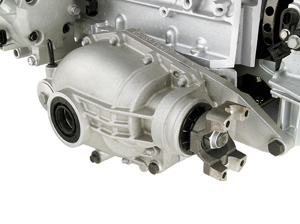The most often replaced drivetrain components on RWD vehicles are the U-joints, and halfshafts on FWD cars and minivans.
U-joints are mounted on both ends of the driveshaft on RWD vehicles so the driveline can move up and down to follow the motions of the suspension. Each U-joint consists of a four-point center cross with needle bearing cups mounted in a pair of yokes. Vehicles with two-piece driveshafts have additional U-joints and/or a CV joint where the two shafts are joined and supported by a center carrier bearing.
 U-joints are “phased” (positioned) 90 degrees to one another to reduce driveline vibrations. Almost all late model original equipment U-joints are sealed, but some older vehicles and trucks have grease fittings. Some aftermarket replacement U-joints are also available with grease fittings for customers who want the ability to grease these parts as needed. A worn U-joint may cause a vibration at speed or make chirping noises, or produce a clunk when putting the transmission into gear. Replacing a U-joint usually requires using a press to remove and install the joint on the yokes.
U-joints are “phased” (positioned) 90 degrees to one another to reduce driveline vibrations. Almost all late model original equipment U-joints are sealed, but some older vehicles and trucks have grease fittings. Some aftermarket replacement U-joints are also available with grease fittings for customers who want the ability to grease these parts as needed. A worn U-joint may cause a vibration at speed or make chirping noises, or produce a clunk when putting the transmission into gear. Replacing a U-joint usually requires using a press to remove and install the joint on the yokes.
U-joints are not used on front-wheel drive applications because they can’t handle large operating angles. Constant velocity joints are needed for this purpose. Each halfshaft will have a CV joint on each end (one inboard joint and one outboard joint). Outboard joints are designed to handle wider operating angles so the wheels can steer, while inboard joints are designed to plunge in and out so the driveline can follow the motions of the suspension.
Basic types of CV joints include Rzeppa, crossgroove, double-offset and tripod. All of these except tripod joints have six small balls housed between and an inner and outer race. A cage with windows holds the balls in position as the joint flexes. Rzeppa CV joints are most often used as the outer joints on the halfshafts. Crossgroove and double-offset joints can “plunge” in and out and are often used as inner joints on halfshafts. Tripod joints contain no balls but have three roller bearings mounted inside a “tulip” or “claw” shaped housing. Tripod joints may be fixed or the plunging variety. Tripod CV joints are mostly used as the inner plunge joints on domestic FWD applications, but may also be used as outer joints on certain import applications.
CV joints require special grease that is packed inside the joint and sealed up with a protective rubber or plastic boot. Boot damage can allow loss of grease and joint contamination with dirt or water, leading to joint failure. Damaged boots should be replaced immediately, but are often not discovered until the joint has lost its grease or been contaminated by dirt or water. A typical symptom of a failing CV joint is clicking or popping sound when turning. Failing inner joints may cause a clunk or vibration when accelerating. CV joints may be replaced separately, but replacing the entire halfshaft assembly is usually much faster and easier.
Replacement joints or shafts must have the same number of splines as the original, and be the same length as the original. It’s a good idea to measure and/or visually compare the old and new parts to make sure they match. On vehicles with ABS, there may also be a wheel speed sensor ring on the housing, which must also be the same as the original.
Damaged boots on CV joints can be replaced, provided the CV joint is still okay. The old joint should be cleaned and inspected, then repacked with CV joint grease before the new boot is installed. This requires removing the halfshaft from the vehicle. A special tool may be needed to install the boot clamps or to crimp the boot collar in place.
Other driveline parts that may need to be replaced include the wheel and axle bearings. On older vehicles and some 4WD trucks, the wheel bearings may be serviceable and require periodic inspection, cleaning and repacking with special wheel bearing grease (never ordinary chassis grease). But on most vehicles, the wheel bearings are sealed and have to be replaced as a cartridge or as part of the hub assembly if bad. Worn or loose wheel bearings can cause steering wander and noise.
On FWD cars, a high-torque hub nut is used to hold the outer CV joint in the hub assembly. Nuts that are staked in place should be replaced if removed to replace the wheel bearings or halfshaft. The nut must also be torqued to specifications to assure proper retention after it has been installed.
On RWD and 4WD cars and trucks with live rear axles, the outer ends of the axle shafts are supported by bearings located inside the axle housing. The bearings are lubricated by gear oil in the rear end. Replacement is required if the bearings are making noise, are loose or feel rough when the wheel is spun by hand. Bearings are press fit on the axle, which requires removing the axle to replace them.
Driveline lubricants include chassis grease for U-joints, CV joint grease for CV joints, wheel bearing grease for wheel bearings, and gear oil for differentials, manual transmissions and transaxles (such as 85W-90, 75W-140, etc.). Some transaxles use ATF instead of gear oil as a lubricant. Differentials with “Posi-Traction” or limited-slip require a gear oil with special additives. Follow the vehicle manufacturer’s viscosity recommendations. Synthetic gear oils flow more easily at low temperature and reduce friction.











